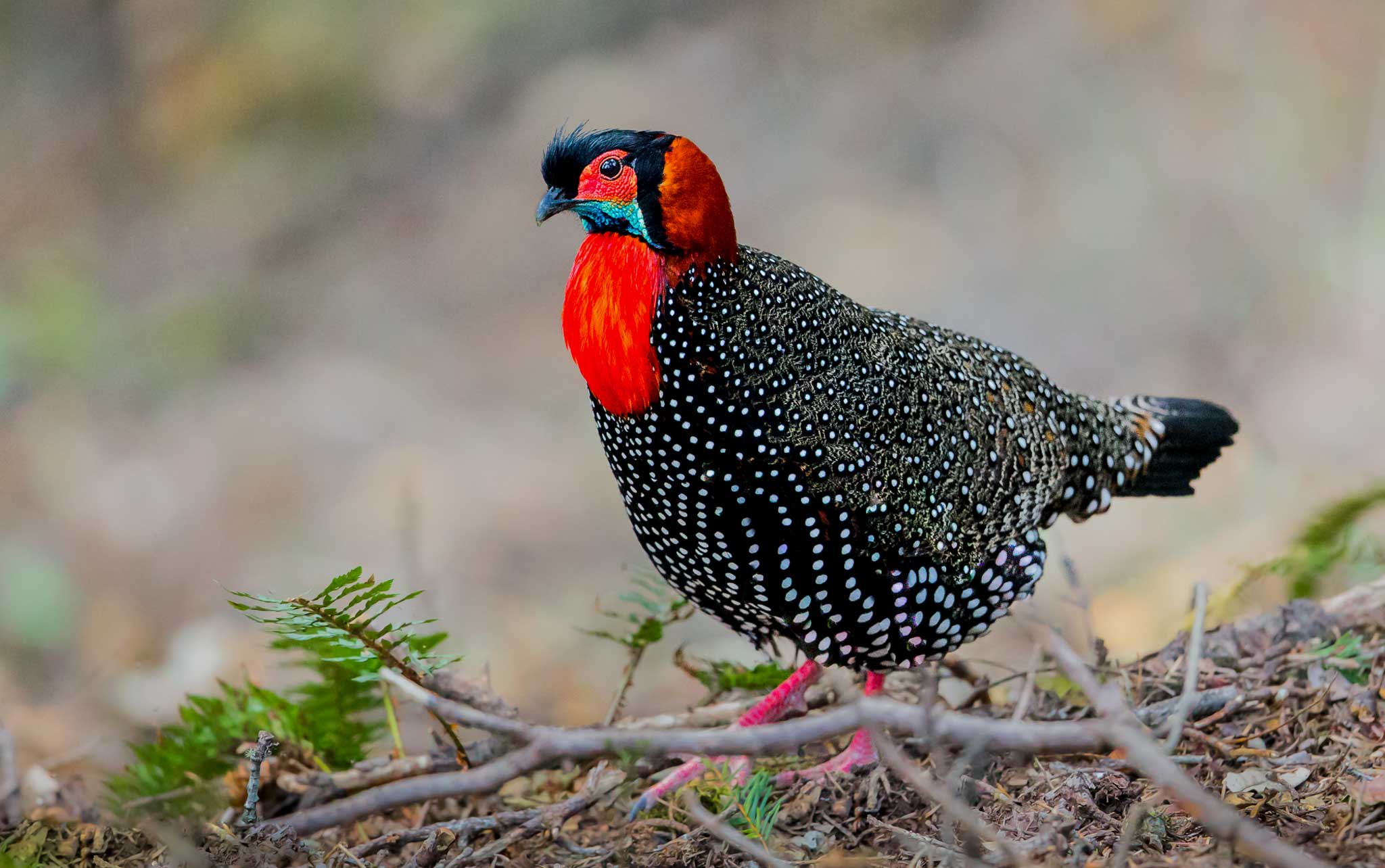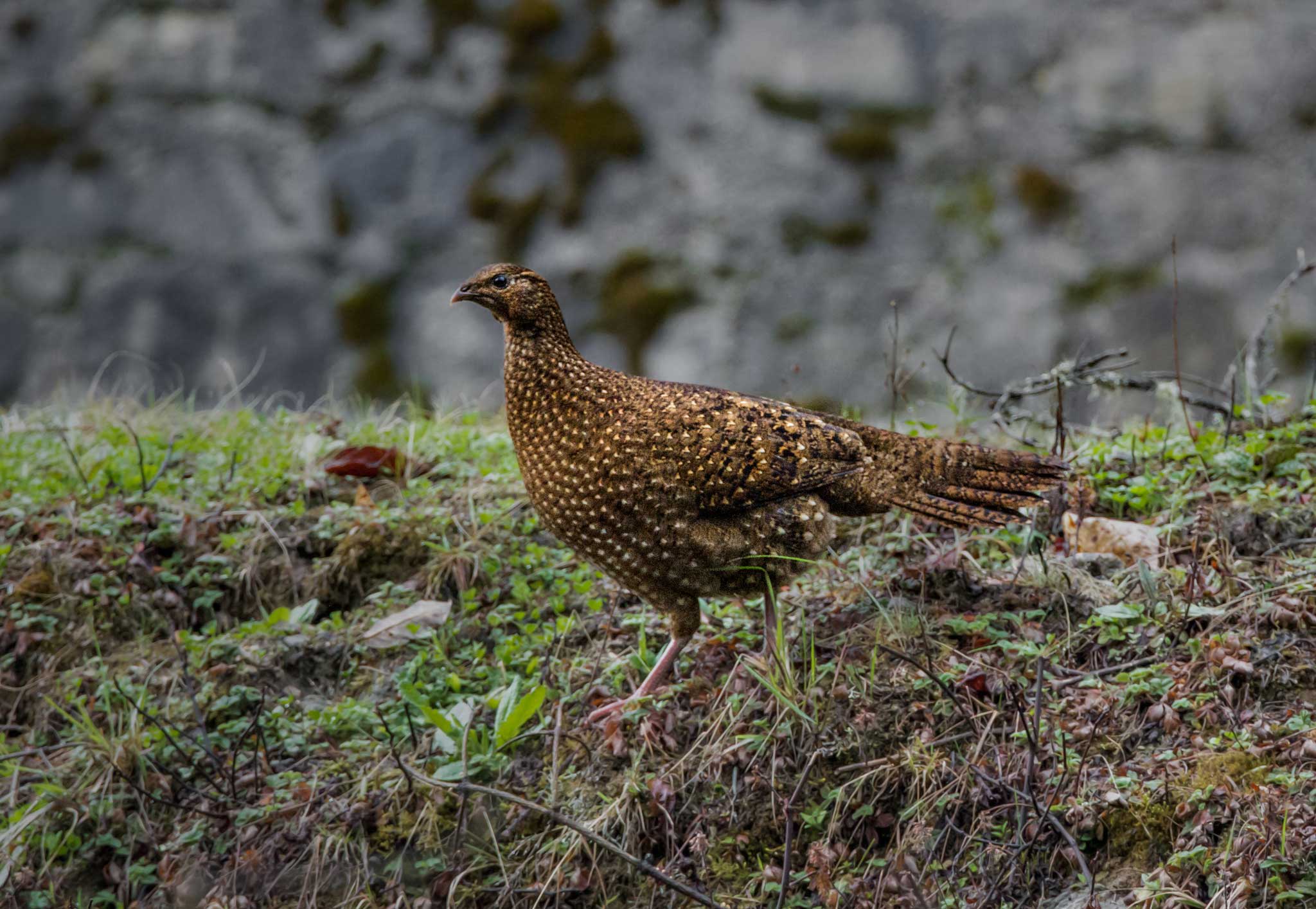A distinctive group of pheasants, the tragopans, reside in India, Nepal, Pakistan, Bhutan and China’s montane Himalayan forests. Their name originates from the union of two Greek words — tragus for goat, and pan, for the half-man, half-goat Greek god. The birds are also known as horned pheasants as the males have two fleshy, erect horns on their heads. During their elaborate courtship, the striking, white-spotted males use the ‘horns’ and the colourful, inflatable skin on their faces and throats to impress drab-coloured females.
Tragopans are very wary and extremely difficult to sight in the wild. They tend to skulk amidst the undergrowth, remaining hidden from view. When disturbed, they usually escape into the branches of a nearby tree. One of the best ways to locate them is by listening to the repeated deep wailing calls of the males during the breeding season. Photographer Jainy Kuriakose, who undertook multiple expeditions to document these rare pheasants between 2013 and 2018, vouches for their elusive nature. “I had to make a lot of efforts to see these birds, especially the western tragopan,” she says.
Out of the five species of tragopans in the world, four can be seen in India — the western tragopan (Tragopan melanocephalus), satyr tragopan (Tragopan satyra), Temminck’s tragopan (Tragopan temminckii), and Blyth’s tragopan (Tragopan blythii). The fifth, Cabot’s tragopan (Tragopan caboti), is found only in China. There are two subspecies of Blyth’s tragopan (T. b. molesworthi and T. b. blythii) and Cabot’s tragopan (T.c. caboti and T. c. guangxiensis).
Unlike other pheasants, which usually nest on the ground, tragopans nest in trees — either in holes or in the old nest of another large bird. Equipped with short, stout bills, tragopans are known to forage on the ground and on trees. The destruction and fragmentation of their habitat coupled with hunting threatens the survival of these stocky, blunt-tailed birds.

A male western tragopan cautiously descends a slope in Great Himalayan National Park in Himachal Pradesh. In India, this pheasant also occurs east of the Great Himalayan National Park in moist to dry Himalayan forests, typically dominated by oak and conifers. It is the state bird of Himachal Pradesh, where it is known as jujurana or the ”king of birds”. The bird’s seasonal movement is dictated by snowfall; in winter it descends from altitudes as high as 3,600 m to 1,735 m.

Darkest among the tragopans, the male western tragopan has blackish body plumage contrasting with a scarlet nape and orange breast; its facial skin is red and throat blue. Of all the tragopans, the western tragopan was the most difficult to sight for Kuriakose, who undertook two expeditions to the Great Himalayan National Park to photograph the bird. “I trekked through the park for seven days in 2015 but had to return without a single sighting. I returned the following year and had almost given up all hopes of seeing the bird by the sixth day. I finally teared up when this individual came down a slope towards the log behind which I had hidden,” she says.

A male satyr tragopan, with its distinctive, gorgeous red underparts and white spots, forages on the leaves and petals of primulas in Bhutan. In India, the bird’s habitat ranges across the central and eastern Himalayas from Uttarakhand in the northwest to Arunachal Pradesh in the northeast. Though shy like other tragopans, the satyr tragopan can sometimes be remarkably confident in areas where it is not persecuted, such as in parts of Bhutan. “I have seen seven males flocking together in Bhutan,” says Kuriakose. This pheasant forages early in the morning, often in moist areas, even by streams. It may also clamber about in trees and bushes, including rhododendron and berberis, to feed on petals, berries, buds, leaves, and invertebrates.

The female satyr tragopan’s plumage is brown, marked with light spots and streaks and irregular bars on the tail. Some females may also be a dull grey-brown. All female tragopans are largely similar in appearance and are usually distinguished based on their range. Found at altitudes ranging from 1,800 m to 4,300 m, satyr tragopans breed between May and June. They place their nests, a crudely assembled structure of sticks, among tree branches. Occasionally, they may also use the old nest of another large bird.

A Temminck’s tragopan sprints across a road at Mandala in Arunachal Pradesh. Named after the Dutch zoologist, Coenraad Jacob Temminck, this pheasant is the most widespread of the genus. In India, it occurs in the forested mountains of Arunachal Pradesh. “I learnt through my guide about a location where a Temminck’s tragopan was sighted crossing a road. Since these birds tend to choose the same area to cross a road, I decided to park myself nearby. I waited at the same location for two consecutive days, from morning to evening, without any luck. The bird finally appeared on the third day and raced away immediately after I clicked this photograph,” Kuriakose says.

Characterised by a flame-orange collar, the Temminck’s tragopan’s red upper parts are covered in white eyespots. “Though wary, like other tragopans, it is sometimes relatively easy to observe in remote areas. Usually encountered singly or in pairs, this pheasant appears to be the most solitary and most arboreal of tragopans. It feeds on the berries of trees such as Sorbus and Viburnum early in the winter and later digs in the snow with its bill for grass and ferns,” write Steve Madge and Phil McGowan in Pheasants, Partridges, and Grouse: A Guide to the Pheasants, Partridges, Quails, Grouse, Guineafowl, Buttonquails, and Sandgrouse of the World.

A Blyth’s tragopan skulks amid the bamboo undergrowth of the Mishmi Hills in Arunachal Pradesh. Named after the English zoologist Edward Blyth, this pheasant is also seen in Nagaland, Assam, Manipur, and Mizoram. It is the state bird of Nagaland. “After tramping an entire day through a forest trail in pursuit of the Blyth’s tragopan, I was about to give up when our local guide said he could see some movement in some bushes near a road. It was beginning to get dark, and I spotted what looked like a flower to me. I had no idea that I had spotted the rare Blyth’s tragopan when I took this photograph,” Kuriakose tells me.

The Blyth’s tragopan is the largest of tragopan species. Unlike other species that sport blue, the male Blyth’s tragopan is distinguished by its bright-yellow facial and throat skin. “I took cover at a nearby culvert in the hope that that the bird would come closer. As I had anticipated, it came down to the road moments later. I took this photograph just as the bird turned to get out of the way of an approaching vehicle,” Kuriakose adds.

The Mishmi Hills in Arunachal Pradesh lie at the junction of the Northeastern Himalayas and the Indo-Burma ranges. Characterised by heavy rainfall and steep slopes, this biodiverse region is a birder’s paradise. The subtropical evergreen forests of these hills, named after the Idu-Mishmi tribe, are home to around 680 species of birds, including Blyth’s and Temminck’s tragopan.